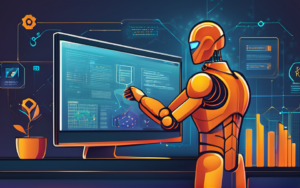In today’s digitally connected world, cybersecurity is no longer just a technical concern; it’s a fundamental aspect of our personal and professional lives. From our online banking to our social media interactions, our data is constantly at risk. But are we doing enough to protect it? This article explores the ever-evolving threat landscape, the importance of data protection, the current state of cybersecurity measures, and the critical gaps that need to be addressed.
The Growing Threat Landscape
The digital world is becoming increasingly complex, and so are the threats we face. The rise of cybercrime has been fueled by a combination of factors, including the accessibility of technology, the growing value of data, and the increasing sophistication of attack techniques. Cybercriminals are constantly innovating, developing new ways to exploit vulnerabilities and steal sensitive information.
The Rise of Cybercrime
Cybercrime is a global phenomenon, with organized criminal groups and nation-state actors engaging in a wide range of malicious activities. From phishing scams to ransomware attacks, cybercriminals are using sophisticated tactics to target individuals, businesses, and governments. The financial impact of cybercrime is staggering, with businesses and individuals losing billions of dollars each year due to data breaches and other cyberattacks.
Sophisticated Attack Techniques
Cybercriminals are increasingly leveraging artificial intelligence and machine learning to automate their attacks and make them more difficult to detect. This includes using deepfakes to create realistic phishing emails and social engineering tactics to trick users into revealing sensitive information. The use of advanced malware and zero-day exploits further complicates the cybersecurity landscape, making it challenging to stay ahead of the latest threats.
The Impact of Data Breaches
Data breaches can have devastating consequences for individuals and businesses. Leaked personal information can lead to identity theft, financial fraud, and reputational damage. Businesses can suffer significant financial losses, regulatory fines, and loss of customer trust. The impact of data breaches extends beyond immediate consequences, as stolen data can be used for future attacks and malicious purposes.
The Importance of Data Protection
In an increasingly digital world, data is a valuable asset, and protecting it is crucial for individuals, businesses, and society as a whole. Data protection is not just about securing sensitive information; it’s about safeguarding our privacy, ensuring the integrity of our systems, and maintaining the trust that underpins our digital lives.
Protecting Personal Information
Our personal information, from our social security numbers to our financial details, is highly valuable to cybercriminals. Protecting this information is essential for safeguarding our identity and preventing financial loss. We must be vigilant about the websites we visit, the information we share online, and the security measures we take to protect our devices.
Safeguarding Business Operations
For businesses, data is critical to their operations, from customer information to financial records. Protecting this data is essential for maintaining business continuity, ensuring compliance with regulations, and preserving the company’s reputation. Data breaches can disrupt business operations, damage customer relationships, and lead to significant financial losses.
Maintaining Public Trust
Data breaches can erode public trust in organizations and institutions. When individuals feel that their data is not secure, they may be less likely to engage with online services, share personal information, or trust businesses with their data. Maintaining public trust requires organizations to prioritize data protection and demonstrate their commitment to security.
Current Cybersecurity Measures
While the threat landscape is evolving rapidly, there are several cybersecurity measures in place to help mitigate the risks. These measures can be categorized into three main areas:
Firewalls and Intrusion Detection Systems
Firewalls act as a barrier between a network and the outside world, blocking unauthorized access. Intrusion detection systems monitor network traffic for suspicious activity, alerting security teams to potential threats. These measures provide a first line of defense against external attacks, but they are not foolproof and require ongoing maintenance and updates.
Antivirus and Anti-Malware Software
Antivirus and anti-malware software protect devices against viruses, malware, and other threats. These programs scan files and websites for known threats, preventing them from infecting your system. Regular updates are crucial to ensure that your software can detect the latest threats.
Data Encryption and Access Control
Data encryption scrambles data, making it unreadable to unauthorized individuals. Access control restricts access to sensitive data, ensuring that only authorized users can view and modify it. These measures help protect data from unauthorized access, even if a system is compromised.
The Gaps in Our Defenses
Despite the existing cybersecurity measures, there are still significant gaps in our defenses that leave us vulnerable to attack. These gaps arise from a combination of human error, outdated technology, and a lack of awareness and training.
Human Error and Social Engineering
Human error is a major factor in many cybersecurity incidents. Employees may accidentally click on malicious links, open infected attachments, or disclose sensitive information to unauthorized individuals. Social engineering attacks exploit human psychology to trick individuals into giving up sensitive information or granting access to systems.
Outdated Technology and Security Practices
Outdated technology and security practices can create vulnerabilities that attackers can exploit. Organizations and individuals need to ensure that their software, hardware, and security measures are up to date and patched against known vulnerabilities. Regular security audits and penetration testing can help identify and address vulnerabilities before they are exploited.
Lack of Awareness and Training
A lack of cybersecurity awareness and training can leave individuals and organizations vulnerable to attacks. Employees need to be educated about common cybersecurity threats, best practices for protecting data, and how to report suspicious activity. Regular training programs and awareness campaigns can help bridge the knowledge gap and improve cybersecurity practices.
A Call to Action: Strengthening Cybersecurity
The threats we face in the digital world are evolving rapidly, and we need to adapt our cybersecurity strategies accordingly. This requires a multi-pronged approach, including investments in advanced security solutions, promotion of cybersecurity education and awareness, and enhanced collaboration and information sharing.
Investing in Advanced Security Solutions
Investing in advanced security solutions is essential for strengthening our defenses. This includes deploying next-generation firewalls, intrusion detection and prevention systems, and endpoint security solutions. Organizations should also consider adopting security information and event management (SIEM) systems to centralize security data and improve threat detection and response.
Promoting Cybersecurity Education and Awareness
Cybersecurity education and awareness are critical for individuals, businesses, and governments. Individuals need to be educated about common threats, best practices for protecting their data, and how to recognize and report suspicious activity. Businesses should invest in cybersecurity training for employees and implement policies and procedures to ensure that data is protected.
Enhancing Collaboration and Information Sharing
Sharing information and collaborating with other organizations is essential for combating cybercrime. Governments, businesses, and security researchers need to work together to share intelligence, develop best practices, and coordinate responses to cyberattacks. This collaboration is crucial for staying ahead of emerging threats and building a more secure digital world.
The Future of Cybersecurity
The future of cybersecurity will be shaped by the convergence of emerging technologies and evolving threats. Artificial intelligence and machine learning will play an increasingly important role in both offense and defense, creating new challenges and opportunities. The increasing interconnectedness of our devices and systems will also create new vulnerabilities, requiring innovative security solutions.
Emerging Technologies and Threats
Emerging technologies, such as the Internet of Things (IoT), 5G networks, and cloud computing, are creating new opportunities and challenges for cybersecurity. IoT devices are often poorly secured, making them prime targets for attackers. 5G networks will increase the speed and capacity of our digital infrastructure, but they will also create new attack surfaces.
The Role of Artificial Intelligence
Artificial intelligence will play a critical role in shaping the future of cybersecurity. AI can be used to automate security tasks, detect and respond to threats more quickly, and develop more sophisticated security solutions. However, AI can also be used by attackers to create more sophisticated and targeted attacks.
Building a More Secure Digital World
The future of cybersecurity will require a collaborative effort from individuals, businesses, governments, and security researchers. We need to invest in advanced security solutions, promote cybersecurity education and awareness, and enhance collaboration and information sharing. Only by working together can we build a more secure digital world where individuals and businesses can flourish without fear of cyberattacks.




